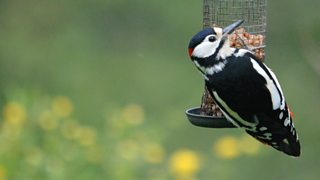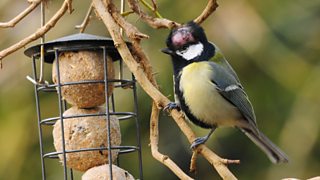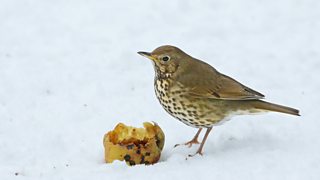By Rob Jaques (BTO Garden BirdWatch Supporter Development Officer)
Bird feeding can be a great way to attract more birds into your garden, even if that space is small or located in an urban area. Bird feeding has become a huge industry – it has been estimated that there is one bird feeder for every nine birds that might use it, holding a collective standing crop of 2,500 tonnes – and is no doubt having an impact on garden birds and other wildlife. As we increase our understanding of the costs and benefits of this food provision, we can all work to ensure we have a positive impact on the species we are hoping to help.

Great spotted woodpecker on feeder. Image by Amy Lewis, BTO
Feeder placement
Choosing the correct placement for feeders will help make sure birds are able to access food easily, while feeling safe. Placing feeders and bird tables close to taller vegetation provides birds with nearby cover should a predator appear. Avoid placing feeders close to low cover, where a cat might hide. Use a pole or hang the feeder from a branch, ideally so that it is four to seven feet off the ground, again reducing the risk from a predatory cat. Birds have been shown to assess the risk of using a particular feeder and preferentially select feeders that are located close to cover, avoiding those that are right out in the open.
Food choices
One of the most exciting elements of choosing what foods to put out in your garden is imagining the many species of birds that might visit. A greater diversity of food will likely attract a greater diversity of birds, though it will also be determined by where you live and local habitats.
- Niger seeds are popular with fine-billed finches, such as goldfinch, siskin and, if you are lucky, a lesser redpoll.
- Peanuts are popular with tit species, Great Spotted Woodpecker and nuthatch.
- Fat balls are popular with a lot of species, particularly long-tailed tit. Important: do make sure to remove any mesh to avoid bird feet getting tangled.
- Dried (or living) mealworms and suet pellets scattered on the ground will be popular with blackbird and starling.
- Millet is great for sparrows.
- Sunflower hearts are popular with most species and are a great way to bring in lots of different birds.
- Mixed seed is tempting, as it seems like they have something for everyone, but quite often birds will pick through to find their favourites, discarding everything else. Setting up separate feeders with different foods will avoid the food going to waste.
- Some table scraps will be appreciated but avoid processed, salty and overly greasy foods. Apples, some vegetables and a small amount of bread/cake/pastry crumbs will be appreciated.

Great tit with avian pox. Image by Tommy Holden, BTO
Feeder hygiene
While feeding garden birds gives many people an opportunity to support their local wildlife and see birds from the comfort of their own home, this does come with responsibility. Diseases can be passed from one individual to another via contaminated surfaces or food, so it is important to keep your feeding stations and bird baths clean.
This responsibility starts with when we buy a bird feeder. Make sure the feeders are easy to clean and can be taken apart easily so you can clean those hard to reach areas.
Feeders and regularly used surfaces (such as bird baths or feeding tables) should be cleaned weekly, with warm soapy water (warm water mixed with 5% bleach works well), rinsed thoroughly afterwards and allowed to dry fully before filling them up with food again. Wash your feeders outside, in a bucket, wear gloves and wash your hands and arms thoroughly afterwards – some diseases can be transmitted from birds to people. It is also a good idea to move your feeding stations around the garden from time to time. This stops discarded food accumulating underneath. Old, wet or spoiled food should be removed immediately.
Some species appear to be more susceptible to disease than others. Finch trichomonosis has devastated Greenfinch numbers in the UK and may also be a factor in recent Collared Dove and Chaffinch declines. Avian Pox affects a number of garden bird species, including Great Tit and Dunnock, resulting in pink, warty growths, often around the eyes or the margins of the beak. Other diseases are less obvious, but may result in birds that appear fluffed up, lethargic and reluctant to move away from feeding stations.
Garden Wildlife Health (), a partnership between BTO, ZSL, RSPB and Froglife, is a great resource and provides information and advice on the diseases of garden wildlife, including birds. The website can also be used for reporting these illnesses, allowing us to better understand their impact. If you do see an ill or dead bird be sure to report it to Garden Wildlife Health, remove and disinfect feeders and keep them down for at least three weeks.
- Take part in the weekly garden bird survey at
- Contact gbw@bto.org if you have any garden wildlife questions

Image by Edmund Fellowes, BTO
